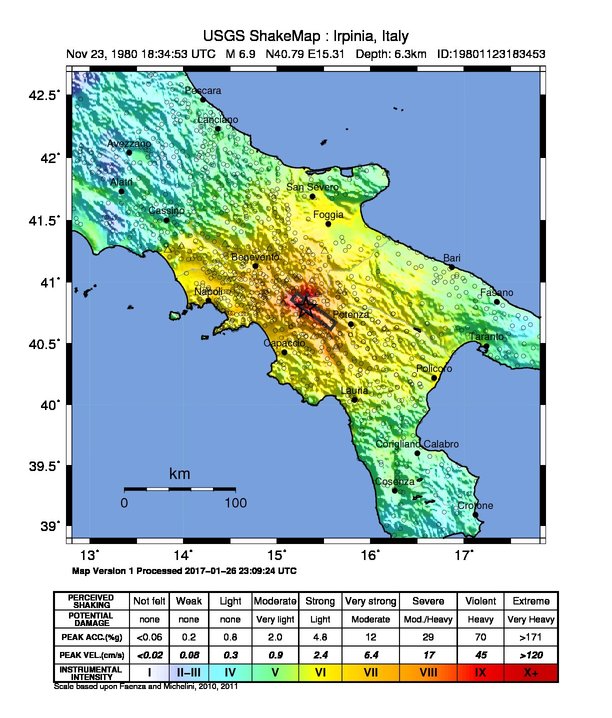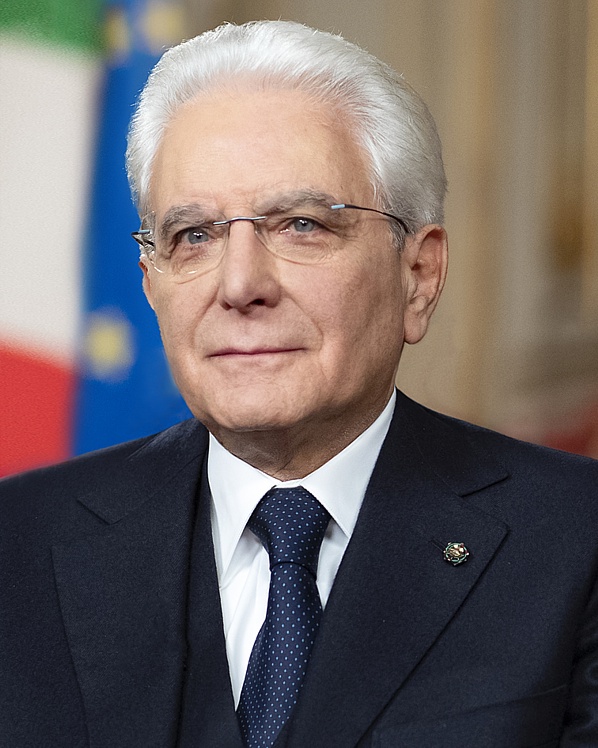|
1980 Irpinia Earthquake
The 1980 Irpinia earthquake () took place in Italy on 23 November 1980, with a moment magnitude of 6.9 and a maximum Mercalli intensity of X (''Extreme''). It left at least 2,483 people dead, at least 7,700 injured, and 250,000 homeless. Earthquake The earthquake struck at 18:34 UTC (19:34 local), centered on the village of Castelnuovo di Conza, Campania, Southern Italy. The first jolt was followed by 90 aftershocks. There were three main shocks, each with epicenters in a different place, within 80 seconds. The largest shock registered a peak acceleration of 0.38 ''g'', with 10 seconds of motion greater than 0.1 ''g''. The three main shocks combined produced 70 seconds of shaking greater than 0.01 ''g''. Thus the shaking was severe and lasted a long time. The focal mechanism corresponded to normal and significant left-lateral strike-slip movement. The rupture dimensions was estimated to be based on the aftershock distribution. The study of near-field strong motion and ... [...More Info...] [...Related Items...] OR: [Wikipedia] [Google] [Baidu] |
Conza Della Campania
Conza della Campania (or Conza di Campania; formerly called Compsa, commonly known as Conza (Campanian: )) is a ''comune'' (municipality) and former Latin Catholic (arch)bishopric in the province of Avellino in the region of Campania in southern Italy. History Early history Compsa was an ancient city of the Hirpini occupied by the Carthaginian conqueror Hannibal in 216 BC. Medieval and modern history During the Early Middle Ages, it was a gastaldate in the Principality of Salerno. In 973, the gastald (city-based Lombard royal domain district administrator and judge) Landulf seized the principality. Later, it belonged to the Balvano, the Gesualdo, and the Mirelli families. Recent history The town was almost completely destroyed by the 1980 Irpinia earthquake. It was rebuilt in the area called Piano delle Briglie, from the former center. Conza della Campania is now a turistic attraction, since it can count among its territory the WWF Oasi, including the lake of ... [...More Info...] [...Related Items...] OR: [Wikipedia] [Google] [Baidu] |
Strong Ground Motion
In seismology, strong ground motion is the strong earthquake shaking that occurs close to (less than about 50 km from) a causative fault. The strength of the shaking involved in strong ground motion usually overwhelms a seismometer, forcing the use of accelerographs (or strong ground motion accelerometers) for recording. The science of strong ground motion also deals with the variations of fault rupture, both in total displacement, energy released, and rupture velocity. As seismic instruments (and accelerometers in particular) become more common, it becomes necessary to correlate expected damage with instrument-readings. The old Modified Mercalli intensity scale (MM), a relic of the pre-instrument days, remains useful in the sense that each intensity-level provides an observable difference in seismic damage. After many years of trying every possible manipulation of accelerometer-time histories, it turns out that the extremely simple peak ground velocity (PGV) provides t ... [...More Info...] [...Related Items...] OR: [Wikipedia] [Google] [Baidu] |
Italian Lira
The lira ( , ; : lire, , ) was the currency of Italy between 1861 and 2002. It was introduced by the Kingdom of Italy (Napoleonic), Napoleonic Kingdom of Italy in 1807 at par with the French franc, and was subsequently adopted by the different states that would eventually form the Kingdom of Italy in 1861. It was subdivided into 100 ''centesimi'' (: ''centesimo''), which means "hundredths" or "cents". The lira was also the currency of the Albanian Kingdom (1939-1943), Albanian Kingdom from 1941 to 1943. The term originates from ''libra'', the largest unit of the Carolingian monetary system used in Western Europe and elsewhere from the 8th to the 20th century. The Carolingian system is the origin of the French ''livre tournois'' (predecessor of the franc), the Italian lira, and the Pound (currency), pound unit of Pound sterling, sterling and related currencies. In 1999, the euro became Italy's unit of account and the lira became a national subunit of the euro at a rate of €1 = ... [...More Info...] [...Related Items...] OR: [Wikipedia] [Google] [Baidu] |
Italian Government
The government of Italy is that of a democratic republic, established by the Italian constitution in 1948. It consists of Legislature, legislative, Executive (government), executive, and Judiciary, judicial subdivisions, as well as of a head of state, known as the President of Italy, president. The Constitution of Italy, Constitution of the Italian Republic is the result of the work of the Constituent Assembly of Italy, Constituent Assembly, which was formed by the representatives of all the Anti-fascism, anti-fascist forces that contributed to the defeat of Nazism, nazis and the fascist forces during the Italian Civil War. Article 1 of the Italian constitution states: By stating that Italy is a democratic republic, the article solemnly declares the results of the 1946 Italian institutional referendum, institutional referendum which took place on 2 June 1946 valid. The Italy, state is not the hereditary property of the King of Italy, ruling monarch, but instead a ''res publica' ... [...More Info...] [...Related Items...] OR: [Wikipedia] [Google] [Baidu] |
NOAA
The National Oceanic and Atmospheric Administration (NOAA ) is an American scientific and regulatory agency charged with forecasting weather, monitoring oceanic and atmospheric conditions, charting the seas, conducting deep-sea exploration, and managing fishing and protection of marine mammals and endangered species in the US exclusive economic zone. The agency is part of the United States Department of Commerce and is headquartered in Silver Spring, Maryland. History NOAA traces its history back to multiple agencies, some of which are among the earliest in the federal government: * United States Coast and Geodetic Survey, formed in 1807 * Weather Bureau of the United States, formed in 1870 * Bureau of Commercial Fisheries, formed in 1871 (research fleet only) * Coast and Geodetic Survey Corps, formed in 1917 The most direct predecessor of NOAA was the Environmental Science Services Administration (ESSA), into which several existing scientific agencies such as the ... [...More Info...] [...Related Items...] OR: [Wikipedia] [Google] [Baidu] |
Salerno
Salerno (, ; ; ) is an ancient city and ''comune'' (municipality) in Campania, southwestern Italy, and is the capital of the namesake province, being the second largest city in the region by number of inhabitants, after Naples. It is located on the Gulf of Salerno on the Tyrrhenian Sea. In recent history the city hosted Victor Emmanuel III, the King of Italy, who moved from Rome in 1943 after Italy negotiated a peace with the Allies in World War II, making Salerno the capital of the "Government of the South" () and therefore provisional government seat (and de facto Capital) for six months and so one of the former capitals of Italy. Some of the Allied landings during Operation Avalanche (the invasion of Italy) occurred near Salerno. It has 125,958 inhabitants as of 2025. Human settlement at Salerno has a rich and vibrant past, dating back to pre-historic times. In the early Middle Ages it was an independent Lombard principality, the Principality of Salerno, which around ... [...More Info...] [...Related Items...] OR: [Wikipedia] [Google] [Baidu] |
Naples
Naples ( ; ; ) is the Regions of Italy, regional capital of Campania and the third-largest city of Italy, after Rome and Milan, with a population of 908,082 within the city's administrative limits as of 2025, while its Metropolitan City of Naples, province-level municipality is the third most populous Metropolitan cities of Italy, metropolitan city in Italy with a population of 2,958,410 residents, and the List of urban areas in the European Union, eighth most populous in the European Union. Naples metropolitan area, Its metropolitan area stretches beyond the boundaries of the city wall for approximately . Naples also plays a key role in international diplomacy, since it is home to NATO's Allied Joint Force Command Naples and the Parliamentary Assembly of the Mediterranean. Founded by Greeks in the 1st millennium BC, first millennium BC, Naples is one of the oldest continuously inhabited urban areas in the world. In the eighth century BC, a colony known as Parthenope () was e ... [...More Info...] [...Related Items...] OR: [Wikipedia] [Google] [Baidu] |
Teora
Teora is a small town and ''comune'' in the province of Avellino, in the Campania region of southern Italy. Geography Teora is bordered by the towns of Caposele, Conza della Campania, Lioni and Morra De Sanctis. History The origin of the village was recorded by the Greek historian Dionysius of Halicarnassus (1st century BC) and by the Roman historian Marcus Terentius Varro. It was also reported that the ''tribuno della plebe'' Milo died there during the civil war between Julius Caesar and Pompey in the Roman era. In a privilege of 1200, granted by Pope Innocent III to Pantaleone, archbishop of Conza, Teora is referred to using the name ''Tugurium Biarium'' for the first time. In the late Middle Ages and modern era it was a fief hold by several local noble families. Three earthquakes have occurred in Teora, in 1694, 1732, and 1980 respectively; the last earthquake destroyed much of the village's historical and cultural identity. Main sights *Fountain of Monte, also ... [...More Info...] [...Related Items...] OR: [Wikipedia] [Google] [Baidu] |
Lioni
Lioni is a town and ''comune'' in the province of Avellino, Campania, southern Italy. Located in western Irpinia, in the Monti Picentini natural park, the municipality borders with Bagnoli Irpino, Calabritto, Caposele, Morra De Sanctis, Nusco, Sant'Angelo dei Lombardi and Teora. It is from Avellino and is linked by a mountain road to the ski resort of Laceno. History The town's name appears for the first time in a donation dated 883, with which the Lombard prince Sichard granted the abbess of S. Sofia a property located in "Lions" (Lioni). The ancient settlement was probably one of the smaller neighboring towns of Ferentino, a Samnite stronghold destroyed by the Romans during the wars between these two peoples. The remains of Cyclopean walls typical of Samnite fortified villages were found on mount Oppido between Lioni and Caposele. The walls encompassed an area large enough to hold houses, barns, and land for pasture. Numerous clay fragments, primarily from tiles ... [...More Info...] [...Related Items...] OR: [Wikipedia] [Google] [Baidu] |
Medieval
In the history of Europe, the Middle Ages or medieval period lasted approximately from the 5th to the late 15th centuries, similarly to the post-classical period of World history (field), global history. It began with the fall of the Western Roman Empire and transitioned into the Renaissance and the Age of Discovery. The Middle Ages is the middle period of the three traditional divisions of Western history: classical antiquity, the medieval period, and the modern period. The medieval period is itself subdivided into the Early Middle Ages, Early, High Middle Ages, High, and Late Middle Ages. Population decline, counterurbanisation, the collapse of centralised authority, invasions, and mass migrations of tribes, which had begun in late antiquity, continued into the Early Middle Ages. The large-scale movements of the Migration Period, including various Germanic peoples, formed new kingdoms in what remained of the Western Roman Empire. In the 7th century, North Africa and the ... [...More Info...] [...Related Items...] OR: [Wikipedia] [Google] [Baidu] |
Balvano
Balvano ( Lucano: ) is a city and ''commune'' in the province of Potenza (Basilicata, southern Italy). The recent history of Balvano is connected to several catastrophes. In 1944, a steam train stalled in a nearby railway tunnel, suffocating over 500 people. It was also one of the towns nearly destroyed by the 1980 Irpinia earthquake The 1980 Irpinia earthquake () took place in Italy on 23 November 1980, with a moment magnitude of 6.9 and a maximum Mercalli intensity of X (''Extreme''). It left at least 2,483 people dead, at least 7,700 injured, and 250,000 homeless. Eart .... Cities and towns in Basilicata {{Basilicata-geo-stub ... [...More Info...] [...Related Items...] OR: [Wikipedia] [Google] [Baidu] |
Orphanage
An orphanage is a residential institution, total institution or group home, devoted to the care of orphans and children who, for various reasons, cannot be cared by their biological families. The parents may be deceased, absent, or abusive. There may be substance abuse or mental illness in the biological home, or the parent may simply be unwilling to care for the child. The legal responsibility for the support of abandoned children differs from country to country, and within countries. Government-run orphanages have been phased out in most developed countries during the latter half of the 20th century but continue to operate in many other regions internationally. It is now generally accepted that orphanages are detrimental to the emotional wellbeing of children, and government support goes instead towards supporting the family unit. A few large international charities continue to fund orphanages, but most are still commonly founded by smaller charities and religious group ... [...More Info...] [...Related Items...] OR: [Wikipedia] [Google] [Baidu] |





